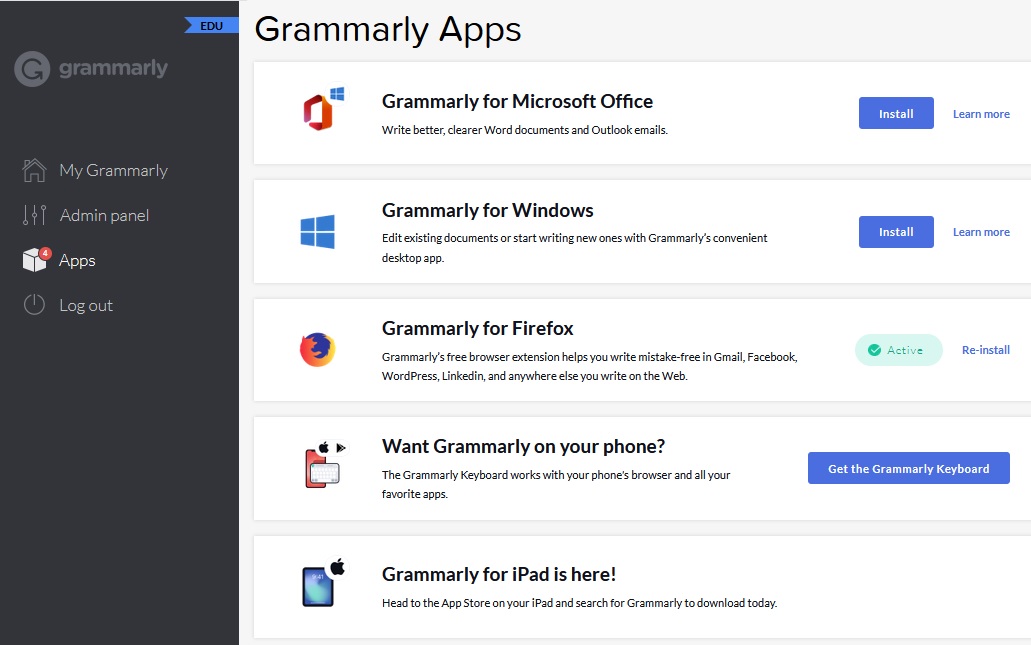Learning Support Tools
Learning Support Tools

iThenticate
The iThenticate programme allows the verification of the originality of a (mainly English-language) document before publication, by comparison with open Internet resources and with databases indexed by iThenticate. We do not recommend checking texts in Polish due to the insufficient reference base.
The programme is aimed at WUT researchers and PhD students - the number of accounts is limited. In 2025 there are available:
- 50 accounts
- 200 checks for the WHOLE University
In scope of your account, you should check your own research work (author or co-author).
There is a pool of checking reports available to you (the number visible in your account, on the right-hand side of the screen, is an indication of how many checks currently remain for the whole university, not for an individual account – the tab: Submit a document / XX Documents remaining
).
Each time the same document is uploaded again it is counted as a new check, so please use the programme with caution.
The results of the analysis are presented in the form of a report, which includes:
- similarity indices (for the whole document and for individual sources), which specify in percentage terms the number of borrowings found in the analysed document;
- highlighted fragments of the work that are identical to the texts found in the comparative databases, together with their source.
If the account is found to be inactive for more than 3 months, it will be deactivated and the user will be informed by email. Significant overage may result in a response from the Programme Administrator.
Please submit your application via the registration form (in Polish; email address in the @pw.edu.pl domain required).
For more information:
Data Management Plans
Data Management Plans

Introduction
Research data are all data that have been collected, generated, observed during the research process aimed at obtaining scientific results.
Research data are:
- raw data (which were obtained directly as a result of a research tool),
- processed data (compiled).
Examples of research data:
- experimental notes, logbooks
- laboratory protocols, procedure descriptions
- methodological descriptions
- samples
- artefacts, objects
- textual documents
- questionnaires, surveys
- audio or video recordings
- photographs, images
- database content (images, texts, audio and video recordings)
- software (scripts, input files)
- results of computer simulations
- mathematical models and algorithms
Open research data – is data produced in the course of research and used in scientific work, to which any user has free and unrestricted access. These data can be used, modified and shared legally.
Some data may be archived in a closed model, due to:
- commercialisation of research results, e.g. applying for patent protection for an invention
- national security
- protection of personal data
- copyright restrictions
Dataset – a structured set of data, made available in a given repository, that relates to a given topic and is provided with metadata describing its content.
Scientific indicators
Scientific indicators

Journals indicators
Selected indicators for scientific journals evaluation:
- Essential indicators:
- Impact Factor
“The annual JCR impact factor is a ratio between citations and recent citable items published. Thus, the impact factor of a journal is calculated by dividing the number of current year citations to the source items published in that journal during the previous two years”. For more information about IF see Thomson Reuters website. - Hirsch index
The index h is defined as the number of papers with citation number >= h, as a useful index to characterize the scientific output of a researcher. An index to quantify an individual’s scientific research output.” It can be also used for journals’ evaluation. The h-index was developed by J.E. Hirsch and published in Proceedings of the National Academy of Sciences of the United States of America 102 (46): 16569-16572 November 15 2005. - Index Copernicus
This evaluation system includes selected journals from STM (Science, Technology, Medicine). It shows the rank of journals based on about 30 parameters in five categories: scientific quality, editorial quality, international availability, market frequency, regularity and stability, technical quality. The IC Journal Master List – contains currently over 8,000 journals from all over the world, including 700 journals from Poland. The journals registered in this database underwent rigorous, multidimensional parameterization, proving high quality. The Ministry of Science and Higher Education acknowledged the IC Journal Master List by placing it on the list of scored databases. The journals indexed in IC JML get additional points during the Ministry’s evaluation process.
- Impact Factor
- Additional indicators:
- SNIP
Source Normalized Impact per Paper - “SNIP measures a source’s contextual citation impact by weighting citations based on the total number of citations in a given subject field. It helps you make a direct comparison of sources in different subject fields.” - SJR
SCImago Journal Rank- ”SJR is weighted by the prestige of the subject field, quality, and reputation of the journal – they all have a direct impact on the value of a citation.”
- SNIP
Sources of the indicators described above:
- Journal Citation Reports - Online Access to JCR (since 1997) on Web of Science
- Journal Citation Reports (JCR) Science Edition
- Journal Citation Reports (JCR) Social Sciences Edition
When looking for JCR database, choose "Additional Resources" after entering the platform ISI Web of Knowledge. - Master Journal List - Master Journal List is in Poland commonly called „lista filadelfijska”. The Master Journal List includes all journal titles covered in scientific products of Thomson Reuters, available on the ISI Web of Knowledge platform, among others in Web of Science (WoS) database. The Master Journal List is than broader than the list of journals available both in WoS and in JCR database.
There is no information on Impact Factor values in the Master Journal List - List of the Ministry’s scored journals - The Ministry of Science and Higher Education publish a list of scored journals once a year.
- INDEX COPERNICUS JOURNALS MASTER LIST (JML) - Current values of Index Copernicus (IC) factors for individual titles, estimated rates for the next year, journal’s publishing address, URL journal’s address, language of publication, availability in international databases). Data are available only for authorized users.
- Scopus - It is an abstract and citation database where the number of citations, the value of h-index (Hirsch index) can be found (publications since 1996). It is also possible to compare scientific journals using the Journal Analyzer feature.
Engineering software
Computer terminals for WUT students and staff available In the Main Library are equipped with specialized engineering software:
- ArcGIS Pro 3.3
- MATLAB 2024A
- Siemens NX 12.0 (installation upon request, contact This email address is being protected from spambots. You need JavaScript enabled to view it.)
- SOLIDWORKS 2024 SP01
- STATISTICA 13.3.721.1 64-bit (Polish language version)
The terminals also feature: MS Windows 11, MS Office Professional Plus 2019, Python, Visual Studio Community and Notepad++ text editor.
Location
Main Building, Main Library:
- Computer Lab, room 71A (ground floor, next to the Student Lending Room)
- Open Stacks – floor 2, room 242
Open during working hours of Student Lending Room and Open Stacks.
Rules for using the Computer Lab
Computer terminals are for the exclusive use of students and staff of Warsaw University of Technology. Login required:
- for employees: name.surename@prac.wut.pl
- for students: id@stud.wut.pl - where id stands for USOS ID, i.e. a part of the student mail login placed before the @ sign.
- password - same as for mail and Office365.
General characteristics of the programmes
- ArcGIS Pro – a geographic information system (GIS) package designed to operate on spatial data. Allows creation, processing, evaluation, presentation and sharing of geographic information. Includes tools for designing two-dimensional and three-dimensional views, processing images from various sources (drones, satellites, lidar and others), identifying spatial patterns with respect to their changes over time, making predictions, presenting data on interactive maps, and comprehensive data analysis and modelling. See detailed information on ArcGIS Pro
- MATLAB – a programming language and interactive environment designed to perform scientific and engineering calculations, implement algorithms, analyse data and perform computer simulations. Application areas include signal and image processing, telecommunications, control system design, financial mathematics, among others. The package includes: a proprietary high-level programming language, tools for importing data, functions to incorporate C and Java code, interactive tools for data visualisation (two- and three-dimensional graphs, animations), a library of computational functions (linear algebra, statistics, frequency analysis, optimisation), and tools for creating a graphical user interface (GUI). It is also possible to download measurement data and control external devices via the computer's ports. See detailed information on MATLAB
- Siemens NX (formerly Unigraphics) – an integrated CAD/CAM/CAE (computer aided design/manufacturing/engineering) system for performing typical engineering work. It includes modules for two-dimensional and three-dimensional graphical modelling, constructing assemblies, performing analyses and simulations, creating drawing documentation and programming machining processes. Main fields of application include industrial design and styling, packaging design, mechanical and electromechanical system design, mechanical and electromechanical simulation, tool and fixed equipment design, product manufacturing and manufacturing process management. See detailed information on Siemens NX.
- SOLIDWORKS – an extensive CAD (computer aided design)software package with 3D imaging capabilities. It is designed for engineers, designers and manufacturers. On the basis of a three-dimensional component model, it enables the creation of assembly models, technical drawings, visualisations, motion and load simulations, animations, task schedules, production documentation and performance of many other specialised functions. SOLIDWORKS is designed for the development of structures with up to several thousand components.See detailed information on SOLIDWORKS
- STATISTICA – an extensive set of basic and advanced tools for statistical data analysis. It allows access to data by direct entry or import from selected files (spreadsheet or text documents), processing of data in a number of ways, and construction of queries, charts, reports and models on their basis. In addition, the programme allows you to operate on databases, perform data transformations and create applications (programmable system with built-in Visual Basic language), as well as providing machine learning procedures. The STATISTICA package finds numerous applications in science, technology, engineering, education and management. See detailed information on STATISTICA


